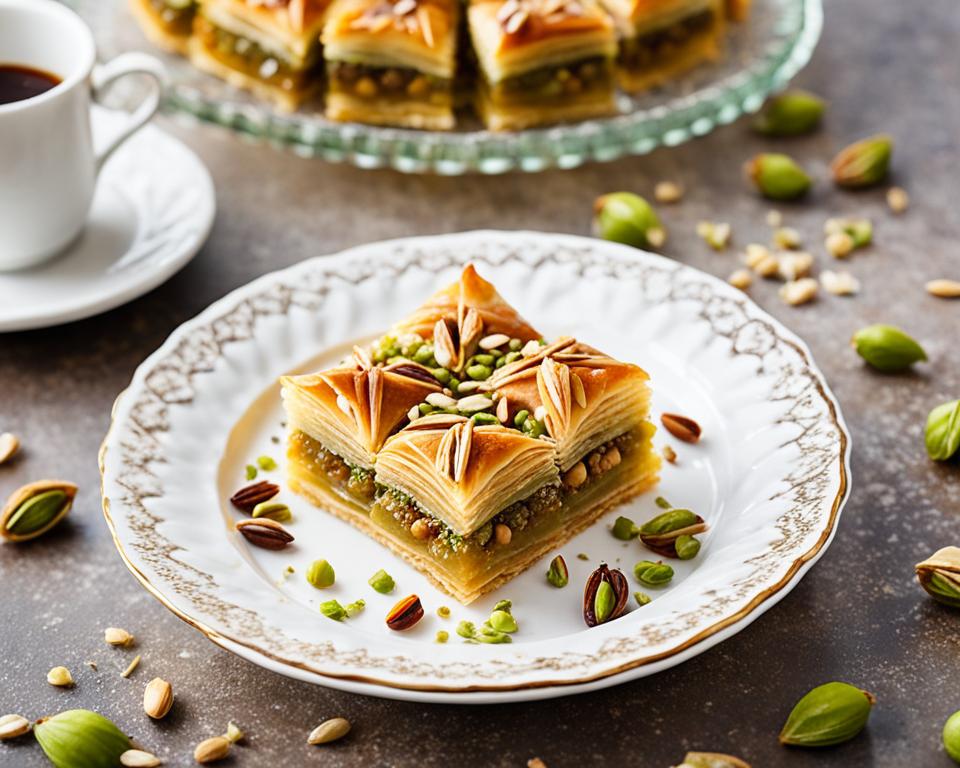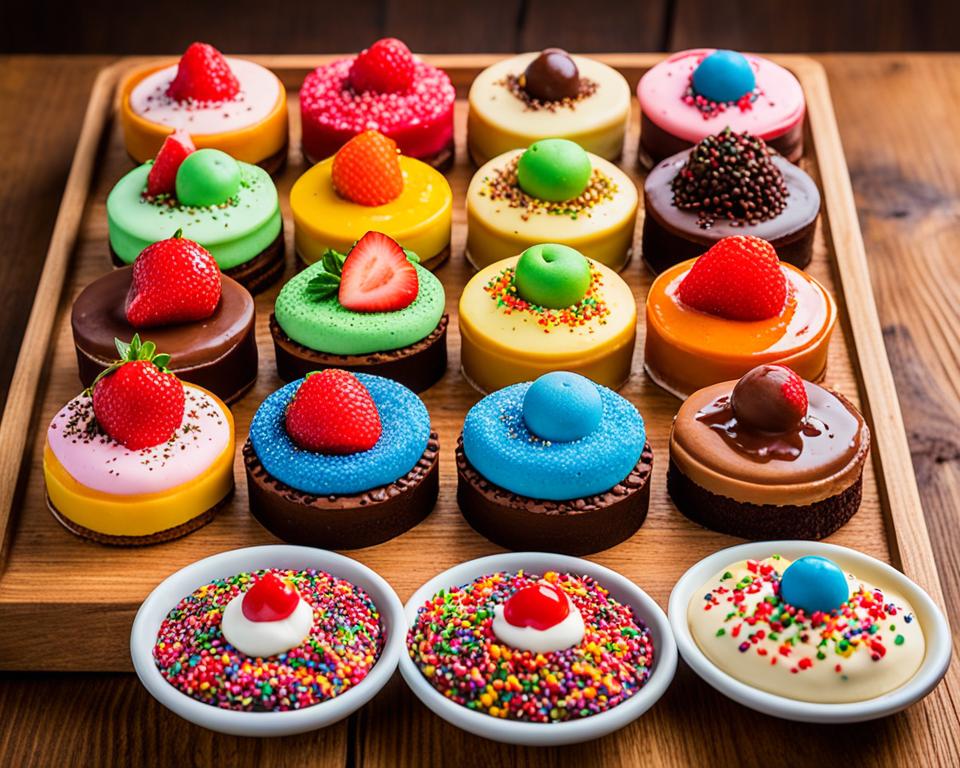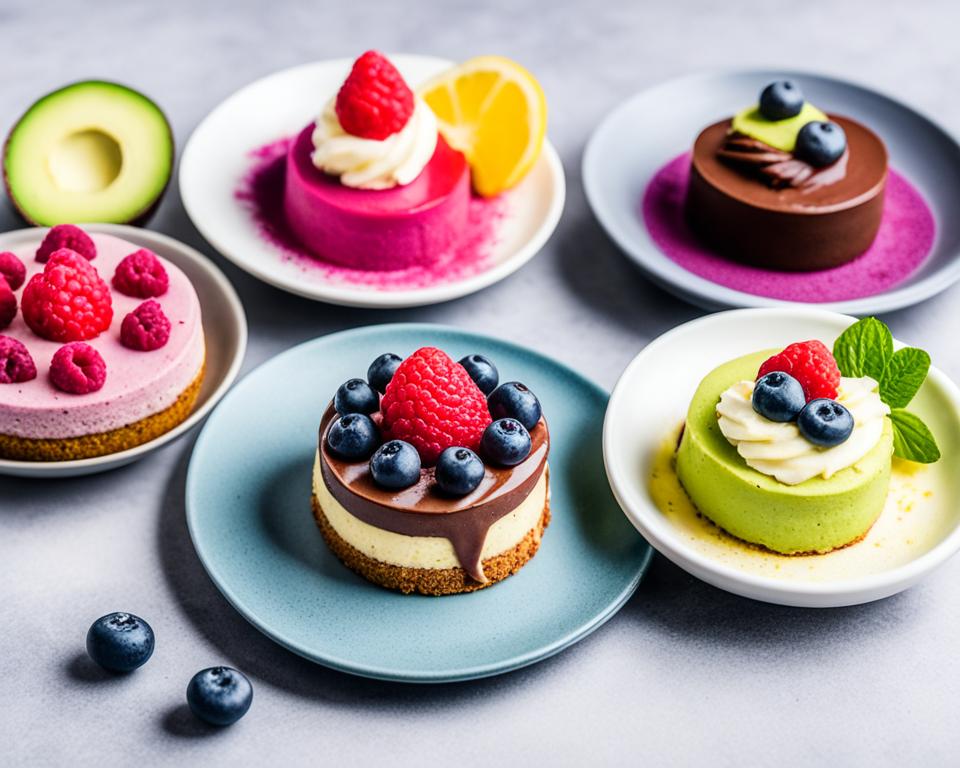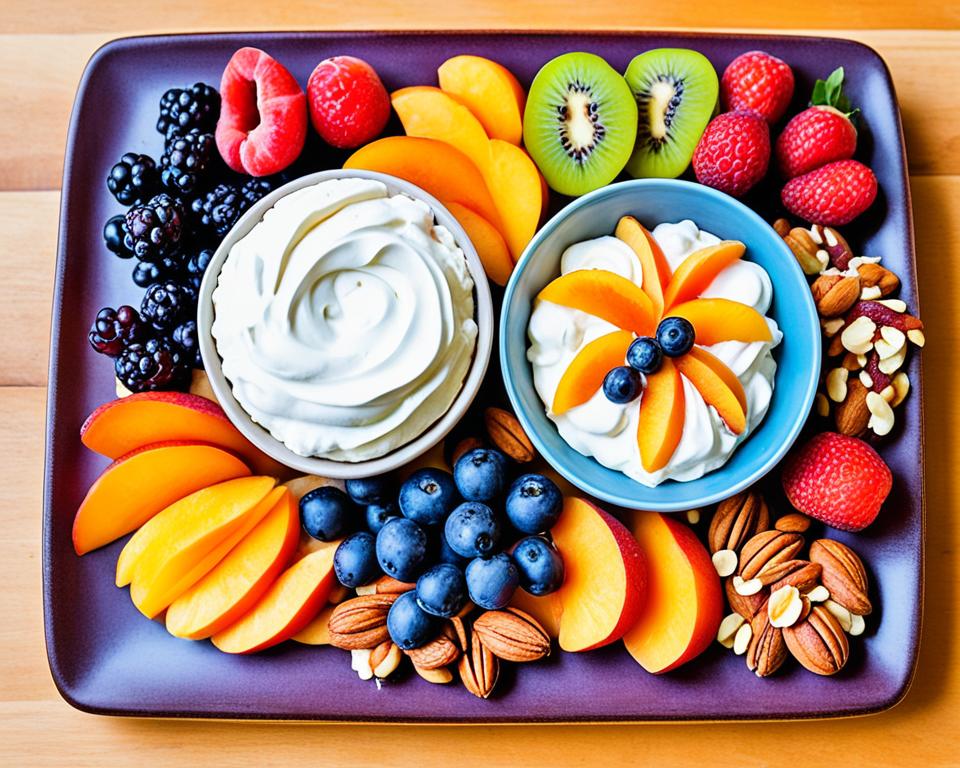Are you craving a delicious, homemade Baklava dessert that is both sweet and flaky? Look no further! Whether you’re a fan of traditional Baklava or looking for an easy recipe to try, this is the perfect guide for you.
Our homemade Baklava recipe has been well-loved and received rave reviews from readers and families alike. It features a delicious honey sauce with a hint of lemon flavor, perfectly complementing the sweetness and cinnamon in the dish.
In this article, we provide detailed instructions on selecting the right phyllo dough, properly buttering each layer, and assembling the Baklava. We even offer suggestions for garnishing your Baklava with chopped nuts or drizzling it with melted chocolate for an extra touch of indulgence.
Ready to get started on your Baklava journey? We also include tips and tricks to ensure your homemade Baklava turns out perfect every single time. From storing and freezing to customizing the recipe to suit your taste preferences, we’ve got you covered.
Key Takeaways:
- Our homemade Baklava recipe is delicious, flaky, and easy to make.
- The honey sauce with a hint of lemon adds a delightful flavor to the dessert.
- Follow our tips and tricks for success in making homemade Baklava.
- You can customize your Baklava with different nuts and spices.
- Store your Baklava properly to maintain its freshness and flavor.
Ingredients for Baklava Recipe
To make this homemade Baklava dessert, you will need the following ingredients:
- 1 package of phyllo dough, thawed according to package instructions
- Unsalted butter
- Walnuts (finely chopped)
- Cinnamon
- Sugar
- Lemon juice
- Water
- Honey
It’s important to use paper-thin phyllo dough for the recipe and not skimp on the butter or any part of the syrup, as they help moisten and soften the layers of Baklava. Additionally, chocolate can be added as an optional touch to elevate the dessert.
How to Make Baklava
Follow these steps to make the best homemade Baklava:
- Start by thawing the phyllo dough according to package instructions.
- Trim the phyllo dough to fit your baking sheet and butter the bottom and sides of the baking pan.
- Next, prepare the honey sauce by combining sugar, honey, lemon juice, and water in a saucepan and boiling until the sugar is dissolved.
- Let the syrup cool while you assemble the Baklava.
- To assemble the Baklava, layer the buttered phyllo sheets and nut mixture, repeating the process multiple times.
- Finish with a layer of buttered phyllo sheets on top.
- Cut the pastry into diamond shapes and bake at 325˚F for 1 hour and 15 minutes or until golden brown.
- Once baked, immediately pour the cooled syrup over the hot Baklava and let it cool completely at room temperature.
- For best results, let the Baklava sit for a few hours or overnight for the syrup to penetrate and soften the layers.

Tips and Tricks for Homemade Baklava
Making homemade Baklava may seem daunting, but with these tips and tricks, you’ll ensure success in creating a delicious dessert that will impress your family and friends.
- Thaw the phyllo dough overnight: To achieve the perfect flaky texture, thaw the phyllo dough overnight in the fridge and let it come to room temperature before starting the recipe.
- Trim and cover the phyllo sheets: If needed, trim the phyllo sheets to fit your baking pan. Keep them covered with a damp towel to prevent drying out while you work.
- Use a spritzer bottle for butter: Applying melted butter between the phyllo layers can be messy. Use a spritzer bottle to evenly distribute the butter and make the process easier.
- Moisten your fingertips: If the phyllo dough sticks to your hands while you’re layering it, keep a bowl of water nearby to moisten your fingertips. This will make it easier to handle the dough.
- Allow the syrup to penetrate: After pouring the syrup over the hot Baklava, let it sit for a few hours or overnight. This allows the syrup to fully penetrate the layers, resulting in a moist and flavorful dessert.
- Get creative with garnishes: To add extra flavor and presentation, garnish your Baklava with chopped nuts or drizzle it with melted chocolate. This will make your dessert even more enticing.
With these tips and tricks in mind, you’ll be well-equipped to make the perfect homemade Baklava. Enjoy the process and savor the sweet and flaky results!
The History and Origins of Baklava
Baklava is a traditional pastry known for its sweet, rich flavor and flaky texture. While its exact origins are unclear, it is believed to have been invented in Turkey during the Ottoman Empire and later modified in Greece. The technique of layering unleavened bread with nuts and honey can be traced back as far as the 8th century B.C.E. during the Assyrian Empire. Baklava has become popular worldwide and is enjoyed in various countries, each with its own unique variations.
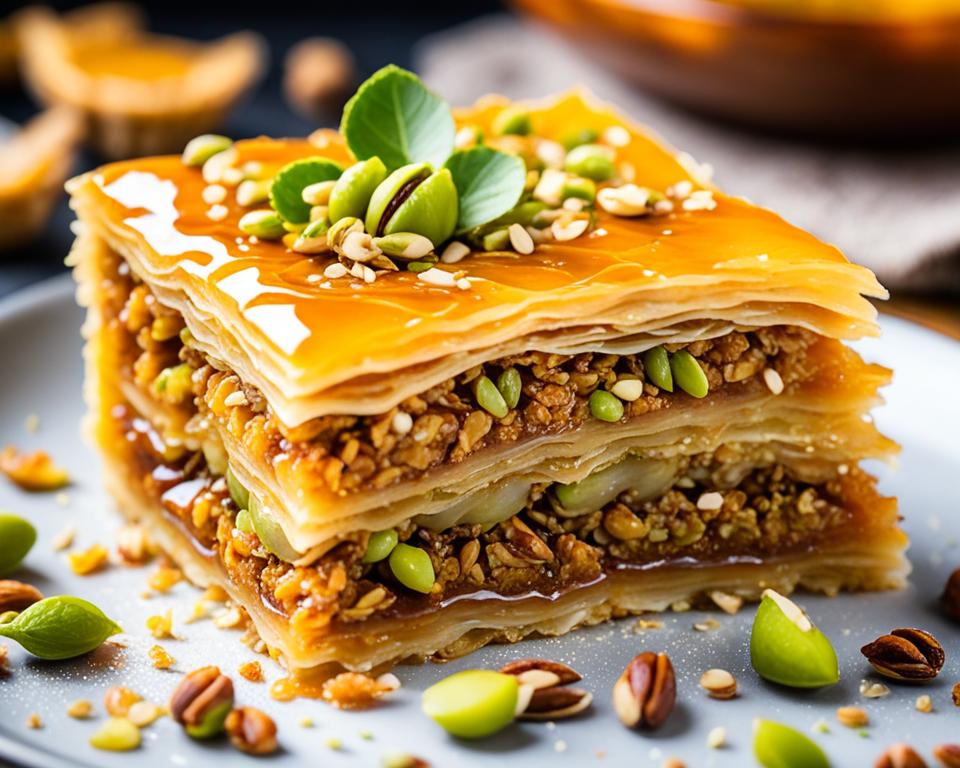
| Country | Variation |
|---|---|
| Greece | Greek Baklava |
| Turkey | Turkish Baklava |
| Lebanon | Lebanese Baklava |
| Bulgaria | Bulgarian Baklava |
Baklava’s origins date back centuries, making it a beloved dessert with a rich history. The exact recipe may vary from country to country, but the essence of Baklava remains the same. It continues to be a delightful indulgence enjoyed by many around the world.
Greek Baklava vs. Turkish Baklava
There is often a debate about the origins and differences between Greek Baklava and Turkish Baklava. While both versions feature phyllo dough, nuts, spices, and a sweet syrup, there are some variations in ingredients and flavors. Greek Baklava typically uses walnuts for the nut filling and honey for the syrup, while Turkish Baklava often incorporates pistachios and may not include honey. The flavors and techniques used in each recipe may also differ slightly, reflecting the culinary traditions of each country.
The table below highlights the main differences between Greek Baklava and Turkish Baklava:
| Ingredient | Greek Baklava | Turkish Baklava |
|---|---|---|
| Nut Filling | Walnuts | Pistachios |
| Syrup | Honey | Varies (may not include honey) |
| Flavor Profile | Sweet and nutty | Sweet with a hint of pistachio |
| Culinary Tradition | Greek | Turkish |
While both versions of Baklava are delicious in their own right, the choice between Greek and Turkish Baklava ultimately comes down to personal preference. Whether you enjoy the rich flavor of walnuts and honey or the unique taste of pistachios, both desserts offer a delightful indulgence.
Storing and Freezing Baklava
Once you’ve made your delicious homemade Baklava using our easy recipe, you may be wondering about the best way to store and freeze it. Proper storage will help maintain the flavor and texture of this delightful dessert for an extended period.
Baklava can be stored at room temperature in an airtight container for 1 to 2 weeks. It’s crucial to ensure the container is tightly sealed to prevent premature spoilage or loss of freshness. This way, you can enjoy a slice of Baklava whenever the craving strikes.
For optimal results, it is recommended to let the Baklava sit for 4 to 6 hours, or even overnight, at room temperature before consuming. This allows the syrup to penetrate and soften the layers, resulting in a more delightful mouthfeel and overall taste experience.
If you prefer a crispy texture to your Baklava, storing it in the pantry at room temperature is the way to go. The exposure to air will help maintain its desirable crunchiness while preserving its flavors. On the other hand, if you prefer a more chewy texture, refrigerating the Baklava will achieve this desired consistency. However, ensure it is sealed in an airtight container or wrapped in plastic wrap to prevent moisture absorption.
Moreover, Baklava can also be frozen for future enjoyment. To freeze your homemade Baklava, tightly wrap it in plastic wrap and then aluminum foil to prevent freezer burn and maintain its quality. Make sure to label the package with the freezing date for easy reference. When you’re ready to indulge, thaw the Baklava in the fridge overnight. This gradual thawing process will help retain the texture and flavors you love.
Proper storage and freezing techniques ensure that you can always have a delicious batch of Baklava on hand to satisfy your cravings. Whether you savor it at room temperature, fresh from the fridge, or after freezing, this decadent dessert will continue to delight your taste buds.
Tips for Storing and Freezing Baklava:
- Store Baklava in an airtight container at room temperature for 1 to 2 weeks.
- Let the Baklava sit at room temperature for 4 to 6 hours or overnight before serving to allow the syrup to penetrate and soften the layers.
- If you prefer a crispy texture, store Baklava in the pantry. For a chewy texture, refrigerate it in an airtight container or wrapped in plastic wrap.
- Freeze Baklava by tightly wrapping it in plastic wrap and then aluminum foil. Thaw it in the fridge overnight before serving.
Baklava Variations and Customizations
While the traditional Baklava recipe is delicious on its own, there are plenty of variations and customizations you can try to make it even more exciting. Here are a few ideas to help you personalize your homemade Baklava:
- Experiment with different types of nuts: Instead of using walnuts, you can try using pistachios, almonds, hazelnuts, or even a combination of them. The choice of nuts can significantly impact the flavor and texture of your Baklava.
- Add additional spices: To enhance the flavor profile of your Baklava, consider incorporating spices such as cloves, cardamom, or orange blossom water. These spices can add a unique twist and create a more complex taste experience.
- Try a different syrup: While the traditional honey syrup is delightful, you can experiment with alternative syrups to suit your preferences. For example, you can use rosewater syrup for a floral note or combine honey with maple syrup for a hint of richness.
- Add chocolate chips: If you’re feeling indulgent, sprinkle some chocolate chips between the layers of your Baklava. The melted chocolate will add a luscious and decadent touch to this already irresistible dessert.
Remember, these variations are just a starting point, and you can let your creativity run wild. Don’t be afraid to explore different flavor combinations and techniques to make your homemade Baklava truly unique and tailored to your taste.
Tips for Customizing Baklava
If you’re unsure where to start with customizing your Baklava, here are a few tips to guide you:
“Don’t be afraid to mix and match different nuts to create a custom nut blend for your Baklava. This can give your dessert an added dimension of flavor and a unique twist.’
“When adding spices, start with a small amount and taste test along the way. Some spices have strong flavors and can easily overpower the delicate balance of your Baklava.’
| Customization | Ingredients | Instructions |
|---|---|---|
| Pistachio Baklava | Pistachios, phyllo dough, butter, sugar, cinnamon, honey, lemon juice | Replace walnuts with pistachios in the nut mixture. Follow the traditional Baklava recipe for assembly and baking. |
| Cardamom Baklava | Walnuts, cardamom, phyllo dough, butter, sugar, honey, lemon juice | Add ground cardamom to the nut mixture for a fragrant twist. Proceed with the traditional Baklava recipe for assembly and baking. |
| Chocolate Chip Baklava | Walnuts, chocolate chips, phyllo dough, butter, sugar, cinnamon, honey, lemon juice | Sprinkle chocolate chips between the layers of the nut mixture. Follow the traditional Baklava recipe for assembly and baking. |
Conclusion
This homemade Baklava dessert recipe is a crowd-pleaser and perfect for anyone craving a sweet and flaky treat. With its layers of phyllo dough, nuts, cinnamon, and honey syrup, it offers a delicious balance of flavors. Whether you stick to the traditional recipe or get creative with variations, making Baklava at home is a rewarding culinary experience. Enjoy the process of creating this delightful dessert and savor the rich flavors. Don’t be intimidated by the steps – follow the tips and tricks provided, and you’ll be rewarded with a homemade Baklava that will impress your family and friends.
By following this easy Baklava recipe, you can enjoy the scrumptious taste of this popular dessert in the comfort of your own home. The combination of crispy layers of phyllo dough, a nutty filling, and a sweet honey syrup is simply irresistible. The recipe is straightforward and the result is a show-stopping dessert that will impress your guests.
So, what are you waiting for? Get your ingredients ready, follow the steps, and indulge in the homemade Baklava goodness. Whether you’re a skilled baker or a novice in the kitchen, this recipe is designed to make your Baklava-making experience a success. Treat yourself and your loved ones to this delectable dessert and create lasting memories around the irresistible flavors of homemade Baklava.
FAQ
What is Baklava?
Baklava is a traditional pastry known for its sweet, rich flavor and flaky texture. It is made by layering phyllo dough with a nut filling and sweet syrup.
What are the ingredients needed to make Baklava?
To make Baklava, you will need phyllo dough, unsalted butter, walnuts (or other nuts of your choice), cinnamon, sugar, lemon juice, water, and honey.
How do you make Baklava?
To make Baklava, you layer buttered phyllo sheets and a nut mixture multiple times, bake it until golden brown, and then pour a cooled syrup over it.
What are some tips and tricks for making homemade Baklava?
Thaw the phyllo dough overnight, keep it covered with a damp towel, use a spritzer bottle for butter, and let the Baklava sit for a few hours or overnight to allow the syrup to penetrate the layers.
What is the history and origin of Baklava?
While its exact origins are unclear, Baklava is believed to have been invented in Turkey during the Ottoman Empire. It was later modified in Greece and has a history dating back to the 8th century B.C.E.
What is the difference between Greek Baklava and Turkish Baklava?
Greek Baklava typically uses walnuts and honey, while Turkish Baklava often includes pistachios and may not use honey. The flavors and techniques used in each recipe may also differ slightly.
How should Baklava be stored and frozen?
Baklava can be stored at room temperature in an airtight container for 1 to 2 weeks. For a crispy texture, store it in the pantry. For a chewy texture, refrigerate it. Baklava can also be frozen for up to 3 months.
Can Baklava be customized?
Yes, you can experiment with different nuts, spices, and even add chocolate chips to customize your Baklava and suit your taste preferences.

